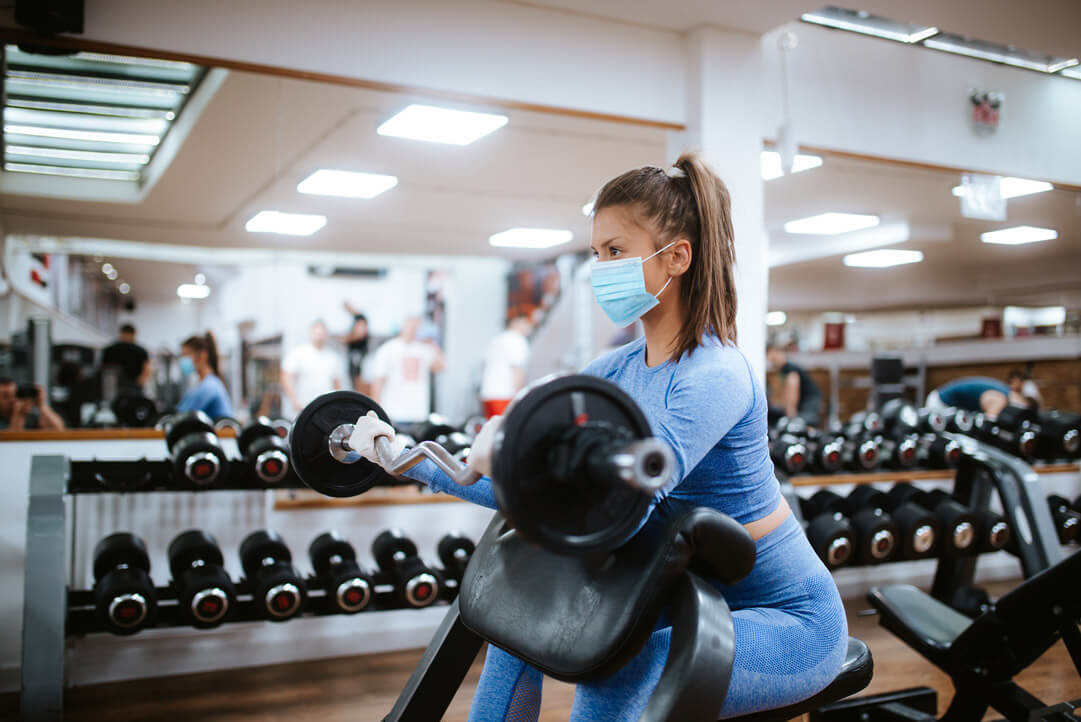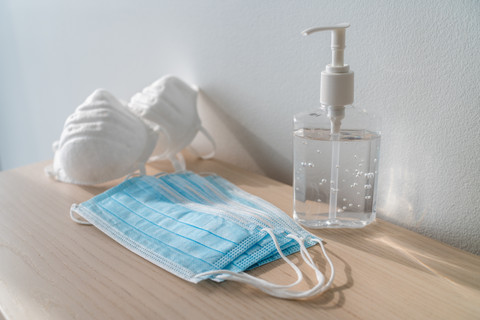There has never been a better time to think about the health and wellness of your eyes. As our world shifts to a new normal, the ways we use our eyes are evolving. Whether you're working from home, preparing your student for virtual learning, or taking advantage of the outdoors to practice social distancing, it's essential to keep your eye safety in mind. Here are the top five things to think about when adapting to your new normal for your eyes!
• Eye safety during COVID-19
• Protecting your eyes during online learning
• Sports and the outdoors
• Home improvement projects
• Visiting your eye care provider
Eye Safety During COVID-19
Although COVID-19 has brought our health and safety to the forefront of conversations over the last few months, eye safety and ocular health have taken a back seat to topics like handwashing and masks. Believe it or not, maintaining proper health and wellness when it comes to eye care can have a significant impact on protecting yourself from this strain of coronavirus.
Even though it feels like COVID-19 has taken over every inch of our lives, especially on the news, here are some of the most important things you need to know about COVID-19 to understand how to protect your eyes.
What is a Coronavirus?
You've probably heard people use coronavirus and COVID-19 interchangeably. However, the two are not the same. Coronaviruses are a family of viruses that cause respiratory tract infections in birds and mammals. While some strains of the virus cause mild reactions, others are lethal. The coronavirus causes illnesses such as some forms of the common cold, pneumonia, and bronchitis. Unfortunately, the virus is also responsible for MERS, SARS, and the newest addition, SARS-CoV-2, also known as COVID-19.
Understanding how COVID-19 spreads is critical to promoting eye safety. Coronavirus can be spread through contact with bodily fluids, primarily saliva. When someone coughs, sneezes, or talks, aerosol droplets of saliva leave their mouth, find their way into the mouths and noses of those nearby as they breathe, and can be deposited onto surfaces and then onto the hands of others.
According to the Centers for Disease Control and Prevention (CDC), it can take between three and 14 days for someone who comes into contact with COVID-19 to begin displaying symptoms, the most common of which are fever, dry cough, shortness of breath, and a sore throat. This means that someone who is infected may feel completely fine for up to 14 days while still being able to transmit COVID-19. World Health Organization (WHO) research has shown that between 40 and 45 percent of people infected with COVID-19 are asymptomatic, meaning they are infected and can transmit the virus to others but do not display symptoms or they have very mild symptoms. The transmission methods and the high rate of asymptomatic transmission highlight the importance of wearing not only a mask but also social distancing.
Contacts and Glasses During COVID-19
For people who wear glasses and contacts, staying safe from COVID-19 means paying even more attention to how and when you touch your eyes. Although there has not been any research published into whether or not people who wear contacts versus glasses are at a higher risk of infection, it's impossible to deny that wearing contacts means you're touching your eyes daily.
Maintaining eye safety while wearing contacts means taking extra care to ensure your hands and face are clean before putting in or taking out your contacts. It's also crucial to replace the contacts solution in your case daily to help remove any buildup.
If you find yourself touching your eyes during the day, transitioning to glasses until the threat of COVID-19 subsides can be an excellent idea to help put a bit more distance between your eyes and your hands by forcing you to pause to move your glasses before touching your eyes. On the chance you must touch your eyes, make sure to wash your hands before for at least 20 seconds with soap and warm water, taking time to clean the tops of each hand, in between your fingers and under your nails. After touching your contacts, rewash your hands.
In addition to helping prevent excessive eye touching, glasses can provide an extra layer of protection from the virus. Although it's not something many people think about, it is possible to have respiratory droplets enter your body through your eyes. Wearing prescription glasses instead of contacts when in public can provide an extra layer of protection, as can wearing safety glasses for those who work closely with people who may be sick.
Eye Safety While Working From Home and Online Learning
For many people, working from home means spending additional time in front of the computer. Taking extra precautions to keep your eyes healthy and rested is essential, especially if you are increasing your screen time. Another population at risk of eye strain from too much computer time is students. With virtual learning on the rise as we begin a new school year, students will spend more time in front of a screen to engage in lessons, take exams, and even interact with classmates. It's more important than ever to put smart eye safety practices in place to ensure employees and students protect their eyes from damage.
 • Build breaks into your daily schedule
• Build breaks into your daily schedule
• Invest in eye drops
• Reduce screen brightness
• Use blue light glasses
• Avoid screens before bed
One way to reduce and prevent eye strain is to take frequent breaks throughout the day. Set a timer to close your eyes for at least 20 seconds every 20 minutes to help perform a mini eye reset and reduce the strain your eyes can experience from staring at a screen. Although this can be difficult, especially during long classes, meetings, or webinars, it's crucial to your eye health in the long run.
Another issue to watch for is an increase in itchy, dry eyes from increased screen time. Dry eyes can cause headaches, making it hard to concentrate and increasing your desire to touch your eyes. Consider stocking up on over the counter drops for dry eyes or contacting your eye care doctor for any medications you may need to combat eye dryness.
Reducing the brightness on your computer, iPad, or phone screen can also help prevent eye strain and promote eye safety. The brightness reduces the amount of blue light and can make focusing for more extended periods easier and less strenuous. People who work with computers for long periods can also purchase blue light filtering glasses or a filter to place over the screen of your computer to help subdue the amount of blue light the eyes absorb. Also, experts recommend keeping your screens at least an arm's length away from the eyes whenever possible, especially for kids.
Insomnia and the disruption of sleep cycles is another eye issue that can be impacted by the use of screens. Although many people use their phones as their alarm clock, it's common for people to browse social media or respond to text messages or emails before drifting off to sleep. Experts recommend disconnecting from your phone or computer screen for at least one hour before going to bed to help the brain adjust to the notion that it should be entering recovery mode at night. Although cell phones and other electronic devices have settings such as Apple's Night Shift that help adjust the color tone of the screen to reduce the impact on the body's sleep cycle, the best way to combat insomnia and brain fatigue from screens is to disconnect completely.
Sports and the Outdoors
If there is one good thing about the pandemic, it is that many people are increasing the amount of time they spend enjoying the outdoors. However, spending time in nature comes with its eye safety issues. If you are planning on spending time outdoors, it's crucial to protect your eyes from damaging UV rays by wearing the appropriate sunglasses. Wearing sunglasses is the best way to protect your eyes from UVA and UVB rays. Sunglasses are essentially like sunscreen for your eyes, and you should wear them at all times when outdoors, even if it's cloudy.
How do you know what sunglasses are best? Unfortunately, the sunglasses' color or tint has nothing to do with the type of UV rays the glasses protect against. Do your research to find the best options for your activities, following some of these best practices:
• Look for closefitting lenses or wraparound styles that protect your eyes from every angle.
• Ensure your glasses have the correct amount of UV protection.
• Although many brands of contacts offer UV protection, it's essential to pair your contacts with the appropriate sunglasses for comprehensive eye safety and sun protection.
Eye Safety During Sports
 Although it appears as though the majority of organized athletic activities will be canceled this year, there are still dozens of ways to engage in sports. However, it's essential to ensure proper eye safety regardless of the type of physical activities you're participating in. In addition to wearing sunglasses, protecting your eyes with other safety glasses or goggles is vital when engaging in activities such as baseball, softball, volleyball, or other activities.
Although it appears as though the majority of organized athletic activities will be canceled this year, there are still dozens of ways to engage in sports. However, it's essential to ensure proper eye safety regardless of the type of physical activities you're participating in. In addition to wearing sunglasses, protecting your eyes with other safety glasses or goggles is vital when engaging in activities such as baseball, softball, volleyball, or other activities.
During warmer months, people can play many types of sports on the beach or sand. Preventing sand from entering the eyes is key during beach or lake sports. Wear protective glasses and ensure you have a contacts case with a backup solution to wash out your eyes if necessary. Don't forget to ensure your little ones have sunglasses and always pack a backup pair just in case!
Eye Safety During Home Improvement Projects
Many people have chosen to take advantage of their additional time at home by completing home improvement projects. Whether you're doing yard work or adding new tile in your bathroom, wearing the proper safety gear is critical. Regardless of the kind of project you're engaging in, don't forget to grab a pair of safety glasses before you begin!
Each day, thousands of people require medical treatment for eye-related injuries, and four out of ten accidents that cause blindness occur at home. Don't become an eye safety statistic, especially during COVID-19. Here are a few times you will definitely need safety glasses or other eye safety devices:
• Yardwork: Creating a new backyard oasis usually means cutting trees, shrubs, bushes, or grass. Working with trimmers, shovels, or mowers can cause dirt, rocks, twigs, thorns, and other debris to fly through the air and damage the eyes. Spreading grass seed, spraying insecticides, or using other chemicals can also be dangerous to the eyes. Don't forget a pair of safety glasses or goggles when you're working on improving your yard!
• Plumbing repair: Installing new or updated plumbing can mean crawling under cabinets and working while lying on your back. Wearing safety glasses or goggles can prevent screws, nails, or other pieces of metal from falling into the eyes.
• Working with wood: Any project that involves cutting wood should automatically involve eye safety wear. Splinters and sawdust can permanently damage the eyes but are efficiently protected against by glasses or goggles.
• Cleaning: Although cleaning is something people usually do with only rubber gloves on, adding eye safety protection is essential. Chemical reactions and fumes from general household cleaners can damage the eyes, lungs, and skin.
• Renovation: When tearing into walls or other surfaces, wearing safety goggles can protect against dust, mold, and other debris that may be flying around.
Regardless of the type of home improvement project you're undertaking, it's always better to be safe than sorry when it comes to eye safety and protection. Experts recommend keeping a few pairs of safety glasses in your garage, shed, and kitchen to ensure easy access whenever you need them.
Attending Eye Care Appointments
You should not delay visiting your eye care provider regularly, especially if you're experiencing eye-related issues or are being treated for specific conditions. Many people believe that because their vision seems fine, they can skip their annual eye appointment.
According to a survey, only 50 percent of Americans visit their eye doctor annually. Although keeping your contacts and glasses prescriptions up to date is essential, eye doctors do so much more than ensure eye safety. Eye exams can detect various other conditions related to overall health, including diabetes, strokes, and high blood pressure.
If any of these six criteria apply to you, it's time to make an appointment to visit your eye doctor:
• You haven't had an appointment within the last year: According to the National Institutes of Health, annual eye exams are the best way to practice eye safety and protect against diseases that can impact your vision permanently. Doctors can detect issues such as high cholesterol, diabetes, and even some cancers by looking in your eyes at your blood vessels, which is another reason why it's important to make routine eye care a part of your annual health routine.
• You have frequent headaches: Even if you think your eyesight is excellent, experiencing frequent headaches can be a sign that your eyes are struggling to focus. When your eyes are attempting to compensate for poor vision, they work overtime. Eye strain, even in small amounts, can lead to headaches that can easily be fixed by corrective contacts or glasses.
• You experience eye pain: Any type of pain within the eyes that doesn't go away is cause for concern. Pain can indicate inflammation, which can be caused by a foreign body in the eye, an infection, sinus issues, dry eyes, or sudden onset glaucoma. Schedule a comprehensive eye exam as soon as possible, so your doctor can determine the best course of action.
• Your eyes are red, swollen, itchy, or sensitive to light: These symptoms can indicate pink eye and a variety of other infections. Although allergic or viral pink eye will eventually go away on its own, others require prescription drops or other treatments and must be approved by a doctor.
• Floating lights appear: Although seeing dark spots or lines in your eyes is common after looking at a bright light, the sudden appearance of flashing or floating lights in your eyes is cause for concern. Also, problems with your peripheral vision can indicate retinal detachment, a condition where the retina lifts away from the back eyewall. This condition is incredibly severe and can lead to permanent blindness is a matter of days if left untreated.
WebEyeCare
Whether you're shopping for new glasses, contacts, sunglasses, or eye safety accessories, WebEyeCare is a fantastic resource for your eye care needs. The company is an authorized retailer for dozens of the most popular contacts and glasses brands and is a resource for people who need to update their contacts or glasses prescription virtually. WebEyeCare works with licensed doctors across the country to provide updated prescriptions to those with glasses or contacts through a series of online tests that you can complete with your cell phone or laptop. Make eye safety a priority with the team at WebEyeCare.
YOU MAY ALSO LIKE:
 Save yourself from getting into rush hours and buy your contacts online.
Save yourself from getting into rush hours and buy your contacts online.








